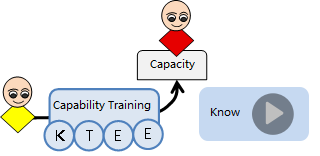|
|
| Successful Case
|
| Continental Automotive Electronics |
| Bosch Automotive Electronics |
| Schaeffler electric drive |
| Joyson Automotive Electronics |
| Huawei Technical Center |
| BMW Automotive Research and Development Center |
| Geely Auto Research Institute |
| Byd Automotive Research Institute |
| |
|
|
|
|
|
|
| Courses > Modeling |
|
 |
|
Use EA for Business Modeling |
Views 
|
|
 |
|
| Havin |
| ith 17 years of industry experience, he has designed and modeled business architecture for banking, telecommunications, and power industries |
| |
|
|
| Time Location: Beijing, Shenzhen and Shenzhen open classes Based on registration |
| Course CostпЉЪ1300$/Person |
|
|
|
| Internal Training: You can customize internal training according to the needs of the enterprise. |
|
 |
Authentication Method:
Understand the competency model before training.
Ability evaluation after training:
Online Examination
Ability Analysis, give learning suggestions
The qualified person shall be issued a certificate as proof of vocational skill qualification
|
 |
|
|
| The understanding of the business requires a panoramic view, from the division of domains to the analysis of the business elements of each business area: processes, resources, functions, components, economics. Gain a comprehensive understanding of the business and effectively define system requirements to establish the foundation and direction for the long-term development of the business. |
|
- Learn about the internationalized business architecture modeling view and methodology
- Learn about EA, a business modeling tool
- Learn about the business model planning process
- Learn about business model documentation
- Learn to use EA to build a complete business model
- Business domain view
- Business function view
- Business process view vs. resource view
- Business economic view and componentized view
|
| Training Target: Requirements Analysts, Business Planners, Business Architects, Business Analysts |
| Student Basis: Experience in business analysis and document writing |
| Teaching method: customized course + case explanation + group discussion, 60% case explanation, 40% practice exercise |
| Training Content: 2 days
|
| 1. Overview of business modeling |
| 1. Modeling views and methods of international business architecture |
- Modeling Methods for Domain Views: IDEF1X and ER
- Functional View Modeling Methods: IDEF0 and DFD
- Modeling methods for process views: IDEF3, OMT, and BPMN
- Modeling Methods for Resource Views: IDEF5 and RAD
- Modeling Methods for Organizational Views :P ERT
- Modeling Approach to Economic View: AHP
- Modeling Approach to Decision Views: GRAI
- Business Component Modeling Approach: CBM
|
| 2. Business modeling tools |
- Introduction to EA tools
- Business modeling plug-in in EA tools
- Extend UML models to meet special needs for business modeling
|
| 3. Business model planning process |
- What is Business?
- Business architecture drives enterprise informatization
- Business architecture facilitates the evolution of the current business
- Implement business optimization based on TOC constraint analysis
- Describe the Business Architecture Modeling Tool
- The process of business architecture planning
- Discussion: What Competencies Should a Business Architect Have?
|
| 4. Documentation of business models |
- Business specification document directory structure planning
- Automate the generation of business specification documents from UML models
- Review, baseline, and change of business specification documents
- Unified versioning of business specification documents
|
| 55. Business scenarios and backgrounds |
- Analysis of the organizational structure of the enterprise
- Enterprise value chain model
- Business role division
- Analyze the business persona work context
- Define business role work tasks
- Define how business roles connect with each other
|
| 2. Business domain view |
| 1. Business domain modeling method - Domain Model |
- Establish and manage business language vocabularies - association analysis, word segmentation
- Business Word Aggregation Class Analysis - Business Entity Object Model
- Business Entity Relationship Model - Entity Relationship Diagram
- Business entity object abstraction model
- Case Study: Industry Domain Model in CIM Data
|
2. Business Rules- Business Rules
|
- Explicit vs. implicit business rules
- Constraint rules, derived rules, and existential rules
- Vague business rule descriptions
- Use the OCL language to describe business rules
- Case Practice: Uncover implicit business rules practices
|
| 3. Business function view |
| 1. Business use case model - Business Use Case Model |
- Separation of business executors in the organizational structure of the enterprise
- Describe the responsibilities of the business executor
- Model use cases based on the responsibilities of business performers
- Unify the granularity of your business use cases
- Describe business use cases, stakeholders, and scenarios
|
| 2. Global analysis of business use case scenarios |
- Categorization of similar business use cases - generalized business use cases
- Overlapping Business Use Case Scenario Slices - Contains business use cases
- Separation of changes in business use case scenarios - Expansion of use case use cases
- Case Practice: Use typed business use cases to improve the efficiency of business function modeling
|
| Fourth, the view of business process and resources |
| 1. Business process model |
- The basic process structure of the business
- Process interaction and feedback
- Process stratification and control
- Process instances and statuses
|
| 2. Business Process Model - Business Process Model |
- A process model based on business use cases
- An activity- and action-based business process model
- Event-based business process model
- State-based business process model
- Process modeling based on business metamodels
- Case Study: Business Process Model in the Power Industry
|
| 3. Business resource model |
- Qualify The Resource
- Quantify The Resource
- Rent The Resource
- Trade The Resource
- Maintain The Resource
- Check Resource Delivery
- Book The Resource
|
| 5. Business economic view and component-based view |
| 1. Business Process Re-engineering - BPR |
- BPR focuses on: cost, quality, service and speed
- BPR Basics: TQM (Total Quality Management), JIT (Just-in-Time Production), WORKFLOW (Workflow Management), WORKTEAM (Team Management), Benchmarking Management
- BPR integration: advanced manufacturing technology, information technology and modern management methods
- BPR integration: Maximize the functional integration of technology and management
- BPR reengineering: break the traditional functional organizational structure and establish a new process-oriented organizational structure
|
| 2. Business componentization model |
- Based on AHP service capability stratification
- Based on AHP service performer stratification
- Componentization of business processes
- Matrix-based Business Componentization Model - CBM
- Case Study: XXX Enterprise Business Componentization Model
|
|
| |
|
|
|
|
|
| Consulting Objective
|
Help build model-driven analysis, design, development, testing |
| Scope Consultation |
Requirements Modeling, Architecture Modeling, Database Modeling, Code Modeling, Test Modeling.
|
| Consultation Method |
Model-driven development process training, modeling and management tool environment construction, combined with actual customer case demonstration, team practice guidance, model evaluation standards formulation, specification formulation |
| Successful Case |
Huawei Research and Development Center, Space Center of Chinese Academy of Sciences, Nanjing 14 Institute, China Mobile Research Institute and so on. |
| For more information:010-62670969пЉМ umlooo@hotmail.com
|
|
|
|
|